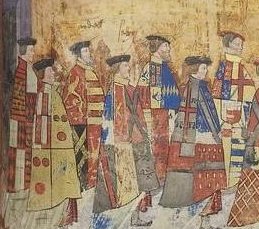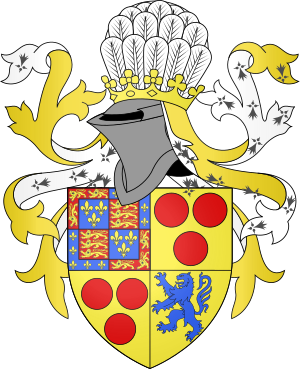Henry Courtenay, 1st Marquess of Exeter facts for kids
Henry Courtenay, 1st Marquess of Exeter, 2nd Earl of Devon (born around 1498 – died 9 December 1538), was an important figure in England during the time of King Henry VIII. He was a grandson of King Edward IV and a first cousin to King Henry VIII. Henry Courtenay and Henry VIII grew up together and were close friends.
Contents
Who Was Henry Courtenay?
Henry Courtenay was born about 1498. His parents were William Courtenay, 1st Earl of Devon, and Princess Catherine of York. Catherine was the sixth daughter of King Edward IV. This made Henry Courtenay a first cousin to King Henry VIII.
His Early Life and Challenges
When Henry was born, his grandfather, Edward Courtenay, was still alive. Henry's father, William, was supposed to inherit the title of Earl of Devon.
However, in 1504, during the reign of King Henry VII (Henry VIII's father), William Courtenay was accused of talking to Edmund de la Pole. Edmund was a rival who claimed the throne. Because of this, King Henry VII put William in the Tower of London. William also lost his right to inherit his father's earldom. This was called being "attainted."
When King Henry VII died in 1509, his son, Henry VIII, became king. Henry VIII was William Courtenay's nephew by marriage. The new king released William from the Tower. In 1511, Henry VIII gave William back his title, making him the Earl of Devon. Sadly, William died just a month later. So, young Henry Courtenay became the heir.
Becoming Earl of Devon
After his father's death in 1511, Henry Courtenay became the Earl of Devon. In 1512, Parliament officially reversed the "attainder" against his father. This meant Henry also inherited his grandfather's older earldom.
In 1513, Henry Courtenay experienced his first battles. He served as a second captain on a warship during a war against France.
As he grew older, Henry became a favorite of King Henry VIII. He joined the King's inner circle, becoming a "gentleman of the privy chamber" and a member of the "Privy Council." This council was a group of trusted advisors to the King.
In 1520, Henry Courtenay went with King Henry VIII to France for a famous meeting called the "Field of the Cloth of Gold." This was a grand event where the English and French kings met. Henry Courtenay was known for being athletic and often went hunting with the King.
In 1521, Henry VIII made Courtenay a "Knight of the Garter." This was a very important honor. He also received some lands that had been taken from a nobleman accused of treason. Over the next few years, Henry Courtenay gained more power. He became the keeper of Burling Park and held important positions in Cornwall. In 1525, he was made the constable of Windsor Castle.
Becoming Marquess of Exeter
On 18 June 1525, King Henry VIII gave Henry Courtenay an even higher title: Marquess of Exeter. At this time, the King of France was a prisoner of the Holy Roman Emperor. Henry VIII sent the new Marquess of Exeter to make an agreement with the French queen, who was ruling in her son's place.
The Marquess of Exeter also helped King Henry VIII with his plan to end his marriage to Catherine of Aragon. He signed a letter to the Pope about this. He was also involved when Cardinal Thomas Wolsey, a powerful church leader, was accused of treason. In 1533, he helped with the official process to remove Catherine as queen.
In 1535, as King Henry VIII began to close down monasteries in England (a process called the "Dissolution of the Monasteries"), he gave Courtenay control over several of them. This put Courtenay in a very important position.
In 1536, a large uprising called the "Pilgrimage of Grace" happened in northern England. This rebellion was by people who wanted to keep the old Catholic ways. Courtenay was sent to stop it, but he was not successful and had to retreat.
Downfall and Death
By the late 1530s, Henry Courtenay was very powerful, especially in western England. However, he became a rival of Thomas Cromwell, the King's chief minister. The two men did not get along.
Courtenay's second wife, Gertrude Blount, remained a Catholic even after the King started the "Reformation" (changes to the church in England). She had connections to the former Queen Catherine. Cromwell used these connections to make the King suspicious of Courtenay's loyalty.
Henry Courtenay also disliked Cromwell's actions, especially how the closing of monasteries affected people. He was said to have joined a group of Catholic nobles, the Pole family, who were against Cromwell's policies. Some historians believe this was not a real plot, but just a group of friends who talked about their disagreements with the King's new ways.
Courtenay was found to be in contact with Cardinal Reginald Pole, a Catholic leader who was against Henry VIII. Cromwell convinced the King that Courtenay was part of a plot against him.
In November 1538, Henry Courtenay, his wife, and his son Edward were arrested and sent to the Tower of London. On 3 December 1538, Courtenay was put on trial. Even though there was little proof, he was found guilty because of his letters to Cardinal Pole.
Henry Courtenay was executed on 9 December 1538, by being beheaded with a sword. His title of Earl of Devon was taken away, and his lands became the King's property. His wife and son were also imprisoned for a time. His wife, Gertrude, was later released and became a friend of Queen Mary I. When Mary became queen, she released Henry's son, Edward, from the Tower.
Family Life
Henry Courtenay was married twice:
- First, he married Elizabeth Grey around 1515. She was a young noblewoman who had been promised to another man before. Elizabeth died soon after their marriage, and they had no children.
- Second, on 25 October 1519, he married Gertrude Blount. She was a lady at court and served Queen Jane Seymour. Gertrude was arrested with her husband but was later released. She became a close friend and lady-in-waiting to Queen Mary I. Gertrude died in 1558.
Henry and Gertrude had two sons:
- Henry Courtenay, who died young.
- Edward Courtenay, 1st Earl of Devon (born around 1527 – died 1556). He spent 15 years in the Tower of London. When Queen Mary I came to the throne in 1553, she released him. She also made him the Earl of Devon.
|




